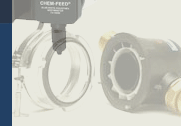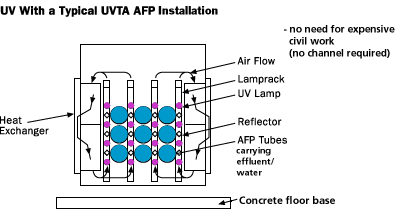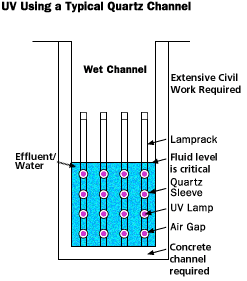| UVTA(TM)
UV Technology
Advantage
|
Alternative
UV Technology
Disadvantage
|
| Non
use of fragile quartz sleeves.
|
Use
fragile quartz sleeve. |
| UV chamber
consists of non-wettable, virtually
non-fouling AFP*.
|
UV chamber
uses quartz, which is negatively
charged and very susceptible to
fouling.
|
| In
situ UVTA(TM) "Autoklyn(TM)",
non-chemical, non-scraping system.
Autoklyn is available as an option
in larger units.
|
Use
of quartz means using corrosive
acids and scraping devices. |
| Control
of UV lamp temperature.
|
No control
of critical UV lamp temperature.
|
| Low
maintenance.
|
High
maintenance.
|
| Ease of
operations.
|
Complex
operations. |
| No short-circuiting.
|
Short-circuiting
will occur.
|
| No critical
effluent levels.
|
Level
of effluent in the channel is
critical.
|
| Static
flow will not damage the UV lamps.
|
Severe
damage will occur if effluent
flow slows or stops whilst UV
lamps still alight.
|
| Low electrical
power consumption.
|
High power
consumption.
|
| Use
of high intensity "XUV", low pressure,
UV Mercury Vapour Lamps operating
48°C to 55°C.
|
Use
of expensive medium pressure UV
Lamps operating > 400°C.
|
| Lowest
time period to change a UV lamp
(less than 1 minute) and is uncomplicated
- the lamp is low cost.
|
Labour
intensive and expensive. |
| No
solarizing of AFP tube in UVTA(TM)
UV chamber.
|
Quartz
is solarized by the UV light at
253.7 nm wavelength, causing the
quartz sleeve to become opaque
and require replacement periodically.
|
| Guaranteed
kill rates with lower UV dosages
due to effective design.
|
Requires
consistent UV overdosing to try
and provide UV dose required.
|
| Proudly
Australian designed and built.
|
Most
other UV systems for effluent
and water disinfection are foreign
imports.
|
| |
|










